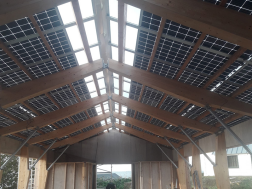In the world’s quest for alternate energy sources, Building-Integrated Photovoltaics (BIPV) is set to revolutionize both architecture and energy harvesting. BIPV incorporates solar cells into building components such as windows and facades, allowing structures to capture renewable energy while contributing to their aesthetic value. In this article, we discuss Why BIPV Technology Does Not Get the Market Attention It Deserves post reviewing its advantages and obstacles, along with the global trends shaping its market adoptions.
While the concept of BIPV is not very old, it has become practical lately with advancements in photovoltaic materials and manufacturing processes. Solar panels have their own advantages, but they fundamentally damage the artistry of the building design. With BIPV systems, the building structure is transformed into a productive unit for harnessing energy and there is no need to conceal the solar panels. These systems achieve numerous forms of energy savings and increases in property value which is very enticing for developers and homeowners.
One of the most notable benefits of BIPV technology is its dual usage as a building and power generator. Because BIPV systems work as both a construction material and a generator, they can help a building to become less dependent on electricity from the grid. This will lower energy costs and reduce the carbon footprint of the building. Besides, increased energy prices coupled with the growing focus on sustainable practices means the demand for BIPV systems will surely increase. Recently conducted market research indicates that the global BIPV market is expected to undergo considerable growth, mainly due to the impetus of technological innovations and supportive policies concerning renewable energy funding, in the upcoming decade.
The integration of BIPV technology also suffers from a lack of certain critical factors that may limit its large scale implementation. Some of these factors include significant initial installation costs which are higher relative to conventional building materials. These could pose a challenge to some developers. Furthermore, BIPV systems have variable efficiency that depends on geographical location, orientation, and prevailing weather conditions. To fill these gaps, new and ongoing research is extremely important. There are significant advancements being made with regards to materials such as organic photovoltaics and transparent solar cells that are expected to drastically improve the efficiency and cost of BIPV solutions.
The BIPV field is poised for change, highlighting several future trends. Primarily, the use of smart technology is becoming more widespread. Smart BIPV systems use real-time data to improve the energy balance of the building, and its efficiency, and advanced urbanization BIPV systems will be important in the frameworks for the sustainable development of cities and their infrastructure.
Furthermore, we underlined smart technology and its role in the development of BIPV technologies. Accepting technological rewards helps to achieve sustainable development goals. Integrating energy-generating technology on the facades/surfaces of buildings boosts the prospects of achieving both actively managing emissions and the operational carbon footprint of a building’s lifecycle.
Overall, the sustainably holistic approach to building architecture helps to integrate BIPV in a absolute innovative ways throughout the energy construction.” Keeping devices on standby reduces wasteful energy Almost every electronic device consumes energy when switched off. Therefore, many electronic devices need manual supervision. The more complex a system becomes or the more services it incorporates, the greater the energy demands. BIPV technologies can drastically shift stagnated construction methods of fossil fuel favouring structures converting traditional buildings into more eco-friendly assets.




